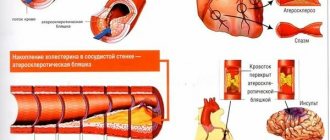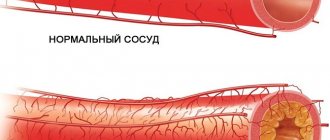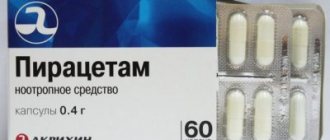Symptoms of cerebral atherosclerosis
If a patient has cerebral vessels affected by atherosclerosis, symptoms and treatment can be quite varied. However, there are a number of manifestations of this disease that are common to most cases.
- The initial stage of the disease is characterized by negative changes in the psyche. The patient becomes irritable, often experiences neuroses, depressive moods, gets tired quickly, and feels inhibited. Unreasonable headaches occur, the head sometimes becomes heavy, and sometimes a pressing feeling appears. And the main symptom is memory impairment: first, the patient has difficulty remembering new information, and then cannot remember past events.
- Then atherosclerosis of the cerebral vessels manifests itself in the form of more serious mental disorders. Patients are constantly concerned about their own state of health and suspect various pathologies. Delusions of persecution often occur, and sensitivity to external factors (stress) increases. New physiological symptoms appear: tingling, burning in different parts of the body.
- In an advanced state, the patient practically loses the ability to care for himself, and dementia develops. The patient does not remember new information, although he can still remember past events. He is disoriented in time and space, and therefore requires constant supervision. Transient ischemic attacks occur with disorders of speech, vision, and sensitivity. Circulatory disorders in the brain lead to spasms and strokes.
Symptoms
Atherosclerosis of the cerebral arteries is asymptomatic or with minimal severity for a long time. Clinical signs of this cerebrovascular disease (CVD) appear when the cholesterol plaque becomes large enough to block blood flow. Atherosclerosis of cerebral vessels is classified according to severity and localization, as well as clinical course.
Signs of atherosclerosis of the vessels of the head and neck
Experts distinguish 3 degrees of severity of cerebral atherosclerosis:
- First degree. Symptoms of the disease appear rarely, most often during psycho-emotional and physical stress, and mental stress. The disturbances are transient.
- Second degree. Functional vascular disorders gradually turn into morphological ones. Signs become more pronounced.
- Third degree. Ischemic attacks occur regularly and irreversible changes occur in brain tissue. The affected areas are replaced by connective tissue and lose their functions.
According to the degree of localization, cerebral atherosclerosis of the internal carotid artery, small-diameter vessels, posterior cerebral artery, and brachiocephalic trunk are distinguished. According to the nature of the clinical course, cerebral atherosclerosis can be latent, intermittent, slowly progressive, stenotic and malignant.
Despite the multivariate course of cerebral atherosclerosis, its symptoms are similar. The complex of symptoms that is characteristic of cerebrovascular accidents is called discirculatory encephalopathy (DEP). With grade 1 encephalopathy, the clinical manifestations are quite sparse. Patients complain of:
- night insomnia;
- memory impairment;
- decreased concentration;
- headache and dizziness;
- periodic tinnitus;
- increased fatigue during the day.
No ads 2
Against the background of grade 2 dyscirculatory encephalopathy, the patient’s condition gradually worsens. His performance decreases, the quality of work performed deteriorates, his mood often changes, depression appears, and memory is impaired. A person is worried about either pathological drowsiness or persistent insomnia. Neurological symptoms are common. Their nature depends on the location of the cholesterol plaque in the blood vessels of the brain.
With grade 3 discirculatory encephalopathy, the following typical symptoms are:
- acute psychosis;
- decreased intellectual abilities;
- emotional instability;
- complete loss of interests;
- absent-mindedness;
- speech disorder;
- deep memory lapses;
- pyramidal syndrome;
- pseudobulbar syndrome;
- ataxic syndrome.
At this final stage of the disease, the patient almost completely loses orientation in time and environment, mental disorders become pronounced, the person loses self-care skills and requires supervision.
Symptoms of cerebral atherosclerosis appear most clearly at the final stage of the disease.
Causes and risk factors
Pathology occurs due to metabolic disorders and cholesterol circulation. It accumulates in the body and is deposited on the walls of blood vessels in the form of plaques consisting of fibrin and other substances.
Main risk factors:
- excessive drinking and smoking;
- hyperlipidemia (high cholesterol);
- arterial hypertension and other vascular diseases;
- obesity and diabetes;
- constant stress;
- sedentary lifestyle;
- hormonal imbalances.
A person may also be genetically predisposed to this disease (close relatives have had strokes or heart attacks). In addition, there is an age-related risk factor: men over 45 and women over 55 are susceptible to atherosclerosis to the maximum extent.
Causes
Cerebral atherosclerosis is a disease of the arteries of the brain when cholesterol plaques form on their inner wall. As a result of this process, the lumen of the vessels narrows, up to complete blockage. The disease is characterized by widespread prevalence. Such atherosclerosis can develop as early as 30 years of age.
This pathology is characterized by a long asymptomatic course, and symptoms appear much later, usually after reaching 50 years of age. It is more common in males than in females. The development of vascular atherosclerosis occurs under the influence of a wide range of risk factors. One of the main ones is age.
The rapid progression and early manifestation of atherosclerosis is facilitated by:
- metabolic disease;
- diabetes;
- thyroid diseases;
- hormonal disorders;
- obesity;
- abuse of fried and fatty foods;
- fiber deficiency;
- smoking;
- alcohol abuse;
- lack of physical activity.
The risk of developing cerebral atherosclerosis is increased by the presence of arterial hypertension in a patient. Often these 2 diseases develop simultaneously and provoke each other. In addition, vascular pathologies, in particular their damage, become favorable conditions for the formation of atherosclerotic plaque.
Damage to blood vessels is facilitated by frequent infections and chronic intoxication of the body, and frequently repeated psycho-emotional stress. Among the reasons, genetic predisposition plays a decisive role. The main role in the development of atherosclerosis of cerebral vessels belongs to disorders of fat metabolism and the accumulation of “dangerous” cholesterol in the blood.
No ads 1
As a result, the concentration of low-density cholesterol increases. It is this substance that is deposited on the inner surface of the arteries and blood vessels of the brain. In cerebral atherosclerosis, mainly arteries of large and medium caliber are affected.
First, a fatty spot forms, then it becomes “overgrown” with calcium salts and increases in size – the result is a cholesterol plaque. It narrows or blocks the lumen of the vessel. This, in turn, leads to a decrease in blood flow to the areas of the brain that feed them.
Thus, ischemia and hypoxia of the brain develop, resulting in the death of neurons. This pathological process is manifested by dyscirculatory encephalopathy: impaired cognitive functions, emotional disorders and motor disorders.
With severe metabolic disorders, cholesterol accumulates on the walls of blood vessels
As the plaque grows, blood clots or blood clots may form. They can break off and enter small cerebral vessels, completely blocking their lumen. As a result, a person develops an ischemic stroke or begins to experience transient ischemic attacks.
At the site of attachment of the cholesterol plaque, the elasticity of the arterial wall is lost over time. An increase in blood pressure in this vascular condition can lead to a hemorrhagic stroke.
Diagnostics
Treatment of cerebral vessels should be preceded by a high-quality diagnosis, during which the doctor will determine the localization of plaques, the degree of their development, and assess the condition of the organs.
When undergoing diagnostics, it is important to follow a comprehensive principle, since the disease has many manifestations and complications. Therefore, do not be surprised if you are also asked to visit an ophthalmologist, cardiologist, neurologist, or vascular surgeon. Try to tell the doctors in as much detail as possible about the anomalies you notice in the body’s functioning.
The most effective and modern methods are:
- various types of electrocardiography with stress tests;
- Ultrasound of cerebral vessels;
- duplex and triplex scanning with ultrasound examination of blood vessels;
- magnetic resonance imaging (allows you to visually assess the condition of blood vessels and examine atherosclerotic plaques);
- angiography, coronary angiography - minimally invasive examinations, during which the doctor evaluates general atherosclerotic lesions.
The patient also undergoes a series of laboratory tests, the purpose of which is to identify metabolic disorders, hormonal imbalances and other causes of the development of pathology.
Diagnostic methods
To identify cerebral atherosclerosis, the following diagnostic methods are used:
- Biochemical blood test to identify the lipid profile. This includes indicators such as cholesterol, high and low density lipoproteins, and triglycerides.
- Ultrasound duplex scanning of the vessels of the head. Used to examine large cerebral arteries.
- Angiography of cerebral arteries. A contrast agent is injected into the arterial system of the neck. After this, small and large vessels are contrasted, which is visible on the X-ray film and the monitor of the device. It is considered the most informative method for diagnosing this disease.
- Computer or magnetic resonance imaging of the brain with the introduction of a contrast agent. Allows you to assess the condition of all brain vessels.
If necessary, when cardiac symptoms are present, it is advisable to examine the coronary vessels for the presence of atherosclerosis of the aorta of the heart. It often happens that atherosclerosis affects several large vessels at the same time.
[node:field_similarlink]
Treatment of cerebral atherosclerosis
If the patient has an early stage of cerebral vasoconstriction, treatment consists of drug therapy and lifestyle changes (diet, giving up alcohol, smoking, increasing physical activity). The goal is to reduce cholesterol levels to normal.
Drug therapy in the treatment of cerebral vascular spasms is aimed at strengthening the walls of blood vessels and stabilizing the atherosclerotic plaque. As a result, the development of atherosclerosis is inhibited, and lipid metabolism in the body is normalized. To prevent complications, statins, fibrates, and antiplatelet agents are used.
Among the surgical treatment methods, stenting and bypass surgery are common. In particular, stroke is prevented by stenting the carotid arteries.
- Operations to remove the plaque are carried out in an open manner (endarterectomy): access to the damaged vessel is organized, it is dissected, the plaque is removed, then a vascular suture is applied, and the tissue is sutured.
- The closed method involves the use of an endoscope and a stent. The operation is performed through a small (1-3 cm) incision, through which access to a large vessel is provided. A special catheter is brought through the circulatory system to the site of narrowing of the vessel, and then an artificial stent is inserted through the catheter, expanding the lumen of the vessel and strengthening its walls.
2. Reasons
To date, the etiopathogenetic mechanism of atherosclerosis continues to be the subject of intensive study and discussion. About ten main hypotheses are considered (viral, hereditary, chlamydia, autoimmune, etc.), each of which has the right to exist and finds well-reasoned confirmation. Perhaps atherosclerosis refers to the so-called. polyetiological, or multi-cause processes, or against the background of these conditions, is triggered by some common, not yet known trigger factor. However, risk factors have been quite reliably established that significantly increase this likelihood:
- - smoking and drinking alcohol;
- — physical inactivity combined with overeating and obesity;
- - arterial hypertension;
- - situations of chronic distress;
- - age-related hormonal changes;
- - diabetes;
- — certain metabolic disorders (metabolism), especially in relation to fats and proteins;
- - “viscosity” of blood (increased coagulability).
Visit our Cardiology page
Prevention of cerebral atherosclerosis
- Daily physical exercise will help keep your blood vessels toned: physical activity that is appropriate for your age should be at least 40 minutes a day.
- To normalize cholesterol levels, watch your diet, weight, follow a special diet, and give up bad habits.
- Walk more in the fresh air to saturate your blood with oxygen.
- Limit emotional stress - protect yourself from stress.
- Monitor your blood pressure and glucose levels.
Treatment
Treatment of the disease depends on its stage, as well as on:
- the patient's well-being;
- risk of complications;
- accompanying pathologies.
As a rule, the therapeutic regimen includes several techniques.
In the initial stages, the disease can be treated with medications. They allow you to normalize blood pressure and lipid metabolism.
Typically, patients are prescribed medications that allow them to:
- reduce cholesterol levels;
- reduce blood pressure;
- reduce blood clotting rates (to prevent the formation of blood clots);
- improve your emotional state.
If necessary, patients also take complexes of vitamins and microelements. Particular attention is paid to B vitamins, which have a positive effect on the nervous system.
The patient’s diet must also be adjusted. Diet is often a condition for recovery. The patient should avoid fried and fatty foods, sweets, processed foods, as well as sausages, canned food, strong tea and coffee.
The correct daily routine also plays an important role in the treatment of atherosclerosis. It is important to pay attention to proper rest. You should sleep at least 8 hours a day. Physical and emotional stress should be moderate. Patients are recommended to do swimming and gymnastics, and take walks in the fresh air.
If you consult a doctor in a timely manner, the disease can be successfully treated. The patient only needs to follow all the specialist’s instructions, eat right and lead a healthy lifestyle. It is also important to get tested regularly. It will allow you to record an important symptom of the pathology at the earliest stage, get rid of it and prevent the development of the disease.
In complicated and advanced cases, cerebral atherosclerosis is treated only by surgical intervention. Typically, operations are prescribed when the vascular lumen is blocked by cholesterol deposits by more than 50% and reduces blood flow.
To increase the lumen, operations such as stenting and angioplasty are performed. A full scale intervention can also be carried out. It is called endarterectomy. The choice in favor of a particular technique is made by the doctor.
Our clinic in Moscow employs experienced specialists. They can prevent the development of pathology and relieve you of all its signs. In addition, professionals adhere to an integrated approach, thanks to which it is possible to eliminate all associated diseases. The prices of therapy will pleasantly surprise even budget-conscious patients. The estimated cost for consultations and examinations is indicated on the website. Our specialists will announce the exact price for all services.
Vascular atherosclerosis: treatment and diagnosis at CBCP
At an early stage of the disease, it is extremely important to undergo a high-quality diagnosis and begin treatment, during which negative consequences can be minimized. If you notice alarming symptoms, contact the Center for Circulatory Pathology, where you will be offered modern diagnostics and effective treatment methods.
CBCP provides a wide range of methods that provide objective and detailed information about the patient’s condition: location of pathology, complexity, possible complications.
How does the disease appear?
In general, cholesterol (a type of fat) is important for the body, as it participates in the construction of vascular walls and is part of hormones and vitamins. In normal metabolism, cholesterol circulates between the liver and tissues; in excess, it is utilized in the liver. If the circulation is impaired, it accumulates in the form of plaques (together with fibrin and other substances) on the walls of blood vessels. The lumen of the vessel narrows, and the blood pressure on the walls automatically increases. Unfortunately, the process is almost inevitable and is observed in 85% of cases in patients over 50 years of age.
The following phenomena gradually develop:
- the walls of the vessel are subject to ulceration;
- scar tissue grows;
- deposits of lime salts are observed on the vascular walls.
The vessel at the site of plaque formation becomes calcified, and this leads to its destruction.








